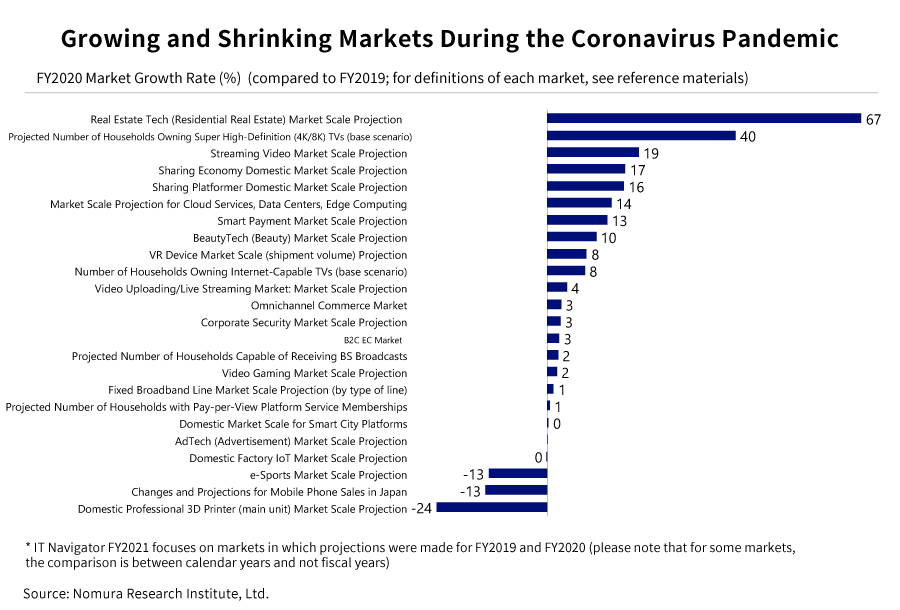“IT Navigator 2021” – Forecasting Market Trends up to FY2026
#DX
Feb. 12, 2021
Every year, Nomura Research Institute (NRI) publishes “IT Navigator”, which offers an outlook on IT markets and provides insight into future business model possibilities. This 2021 edition contains market scale projections for 29 sectors, and also provides commentary on six topics relevant to the new normal. In what follows, Yoichiro Miyake, Kenji Kimura, Kazushige Tsuchihashi, Sayuri Taya, and Yoko Tanaka of the Consulting Division introduce the latest trends and expectations going forward for sectors of particular interest.
In Some Areas, the Spread of Covid-19 Infection has created a Tailwind for the IT Industry – Yoichiro Miyake
Since 2000, NRI has produced “IT Navigator” to analyze and predict IT market trends. Published on December 17, 2020, “IT Navigator 2021” is the 20th edition in the series.
In 2020, a state of emergency was declared due to the spread of Covid-19 infection, and the effects are still being felt today. People have significantly altered their behavior as a coronavirus prevention measure, with shopping and many other processes moving entirely online. In that sense, the coronavirus crisis has been a tailwind for parts of the IT industry.
When these changes are analyzed according to business type, the biggest expansion can be observed in real estate tech. The real estate industry had been lagging in its introduction of IT, but the coronavirus crisis provided the impetus to move IT utilization forward aggressively.
The next largest area of expansion is high-function television, where 4K and 8K TV have spread widely, partly in anticipation of the Tokyo Olympics. The streaming video market has also experienced growth, and the use of video and music streaming services has been on the rise against a backdrop of nest-dweller consumption.
In other words, we can say that the coronavirus crisis has left people with no alternative to using digital services, thus spurring a rapid spread in these services and the infrastructures supporting them.

Telecommunications Market Polarizing due to Medium-Capacity Plans and Low-Rate Plans – Kenji Kimura
In the telecommunications market, as a result of recent mobile phone rate reductions, medium-capacity plans have become the industry’s primary battlefield (despite some difference between main brands and sub-brands), and the ongoing polarization between cost-conscious consumers and consumers who value communication quality has become an issue of interest.
In the field of local 5G, which is based on local 5G networks that general companies and local governments can build and operate directly, applications to open network stations were first accepted in the latter half of FY2019, and the application system began full-scale operation in FY2020. The design and operation of local 5G networks presents technical challenges in regard to the frequencies used, and local 5G is also compatible with Wi-Fi and other connections; because of this, the scale of the market for local 5G communications infrastructure is projected to be around 6 billion yen in FY2020 as a result of regional development, POC, etc., and to reach 18 billion yen in FY2026.
5G is expected to come into flower as a social and industrial infrastructure in the 2030s, and the 2020s can be considered a run-up to that. Once 5G has permeated all sectors and regions, it seems likely that expectations for “Beyond 5G” will rise in the telecommunications market. We can expect that, under the banner of “Beyond5G Ready”, the digitalization of society as a whole, including ICT infrastructure enhancements, will be intensively pursued through integrated industry-government-academic initiatives for “global first”, “innovation”, and “centralized distribution” in pursuit of 6G.
EC Market Faces Headwinds as well as Tailwinds – Kazushige Tsuchihashi
During the coronavirus crisis, there has been a trend toward tightening purse strings and reduced consumer spending, driven by an increasingly defensive mindset around household budgets.
In the brick-and-mortar retail market, although it is true that businesses have been forced to close, home improvement centers have seen rising demand for DIY supplies and camping goods, and have succeeded in maintaining a customer base by virtue of being located in suburban areas where the three C’s can be avoided. On the other hand, department stores and shopping centers have been heavily impacted by tightening consumption because of their dependence on luxury goods, and have experienced delayed recovery due to being located in urban areas where crowds form easily, among other factors.
Against this backdrop, the EC market, which allows consumers to avoid real-world contact, has experienced headwinds and tailwinds simultaneously. For example, while there has been a shift to online shopping and expansion of product sales even amidst the decline in consumer spending itself, this has been counterbalanced by shrinking demand in online ticket sales for airline tickets and live events.
Nest-Dweller Consumption Drives Significant Market Expansion in Video Streaming Market, Prompts Reform in Broadcast Market – Yoko Tanaka
The paid video streaming market has grown in popularity and undergone significant expansion as a form of “nest-dweller consumption” that can be enjoyed at home.
The form of online content viewership has shifted from personal viewing to family viewing, and this trend was continuing even in July 2020, after the first state of emergency was lifted. In addition, the “from real world to net streaming” transformation in spending mentalities is ongoing, with the new spending preferences especially prominent among young people and market growth anticipated going forward. The shift to internet spending has also taken hold among people 30 and older.
Prominent content owner Disney offers an independent streaming platform, and has begun full-scale D2C operations to bring content directly to consumers. Following on Mulan, which had been scheduled for theatrical release in 2020, the animated film Soul (Soulful World in Japan) had its premiere on “Disney+”, the video streaming service directly operated by Disney.
Looking ahead, streaming video service providers will be expected to refine the functions that constitute the unique added value of online streaming, and broadcasters will have to handle the changing viewer needs and expand the viewer contact points that are made possible by the unique qualities of streaming.
“Local Government DX” Failed to Respond to Corona Crisis, Must be Achieved Quickly – Sayuri Taya
Even as the state of emergency declaration was coming into effect, many people still had to go to their local government offices to make inquiries and complete procedures related to government services, or to obtain or submit government documents. We can think of 2020 as the year that truly exposed the problems surrounding the online migration of government processes.
If we understand local government DX as an “initiative to use digital technology to increase the efficiency and sophistication of local government services”, then this DX is already underway in many local governments for operations not subject to restrictions of the My Number Act and for interfacing with residents. However, under the current circumstances, local governments are simply developing and owning systems on their own. It appears that the key to local government DX will be whether the newly established Digital Agency is able to serve as a control tower for standardization of local government information systems, while also acknowledging the discretion of regional authorities.
The “My Number” national identification number system, which can be seen as the core of local government DX, is expected to change significantly due to the impact of the coronavirus. The issuance of My Number cards has proceeded at approximately double the pace of the last fiscal year. In addition, in December 2020, the government released a schedule for revision of the My Number system, under which the next five years are treated as an intensive period. Reforms toward systems rooted in the My Number system are underway in all sectors including government, and in the medical and financial sectors, which are adjacent to public service, these reforms may create new business opportunities.







